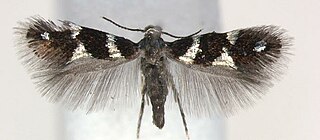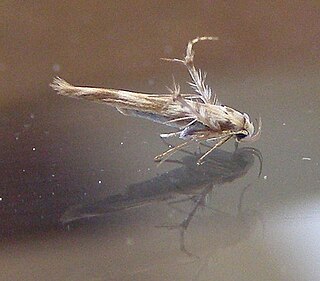
The Plutellidae are a family of moths commonly known as the diamondback moths, named after the diamondback moth of European origin. It was once considered to have three subfamilies: Plutellinae, Praydinae, and Scythropiinae. Praydinae was later elevated to its own family, Praydidae, while Scythropiinae has variously been moved to Yponomeutidae or also elevated to its own family.

The Heliozelidae, commonly known as shield-bearer moths, are a family of small, day flying monotrysian moths distributed worldwide. The larvae of most heliozelid species are leaf miners who cut distinctive shield-shaped cases from the surface of the host leaf, hence the common name. Some species are considered pests of commercial crops such as grapevines, cranberries, and walnuts. The taxonomy of this family is poorly understood.

The Archipini are a tribe of tortrix moths. Since many genera of these are not yet assigned to tribes, the genus list presented here is provisional.

Crambinae is a large subfamily of the lepidopteran family Crambidae, the crambid snout moths. It currently includes over 1,800 species worldwide. The larvae are root feeders or stem borers, mostly on grasses. A few species are pests of sod grasses, maize, sugar cane, rice, and other Poaceae. The monophyly of this group is supported by the structure of the tympanal organs and the phallus attached medially to the juxta, as well as genetic analyses.

Ardozyga is a genus of moths in the family Gelechiidae.

Palumbina is a genus of moths in the family Gelechiidae.

Scoparia is a grass moth genus of subfamily Scopariinae. Some authors have assigned the synonymous taxon Sineudonia to the snout moth family (Pyralidae), where all grass moths were once also included, but this seems to be in error.

Labdia is a genus of moths in the family Cosmopterigidae.

Xyloryctidae is a family of moths contained within the superfamily Gelechioidea described by Edward Meyrick in 1890. Most genera are found in the Indo-Australian region. While many of these moths are tiny, some members of the family grow to a wingspan of up to 66 mm, making them giants among the micromoths.

Thiotrichinae is a subfamily of moths in the family Gelechiidae.
Palumbina chelophora is a moth of the family Gelechiidae. It was described by Edward Meyrick in 1918. It is found in Assam, India.
Palumbina fissilis is a moth of the family Gelechiidae. It was described by Edward Meyrick in 1918. It is found in Assam, India.
Palumbina macrodelta is a moth of the family Gelechiidae. It was first described by Edward Meyrick in 1918. It is found in Assam, India.
Palumbina pylartis is a moth of the family Gelechiidae. It was described by Edward Meyrick in 1908. It is found in Assam, India.
Palumbina glaucitis is a moth of the family Gelechiidae. It was described by Edward Meyrick in 1907. It is found in southern India and Sri Lanka.
Palumbina nesoclera is a moth of the family Gelechiidae. It was described by Edward Meyrick in 1929. It is found in India's Andaman Islands.
Palumbina oxyprora is a moth of the family Gelechiidae. It was described by Edward Meyrick in 1922. It is found in Shanghai, China.
Palumbina tanyrrhina is a moth of the family Gelechiidae. It was described by Edward Meyrick in 1921. It is found on Java in Indonesia.
Palumbina triphona is a moth of the family Gelechiidae. It was described by Edward Meyrick in 1927. It is found on Samoa.
Thiotricha operaria is a moth of the family Gelechiidae. It was described by Edward Meyrick in 1918. It is found in Assam, India.









